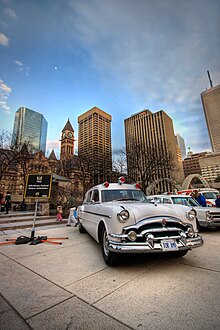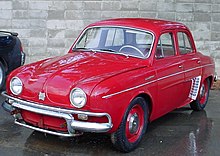Henney Motor Company
| Henney Carriage Works John W. Henney Co. Henney Motor Company |
|
|---|---|
| legal form | Company |
| founding | 1879 |
| resolution | ? |
| Seat | Bloomington , Illinois , USA |
| Branch | Cartwright , automotive industry |

The Henney Motor Company was an American manufacturer of carriages , automobiles, and automobile bodies . Before the Second World War , the company was best known for its funeral vehicles on Packard chassis and after the end of the war for the Henney Kilowatt electric car . Among other things, it also manufactured the Henney Super Wagon .
Company history
Carriages
Henney Carriage Works was founded in 1879 by John W. Henney. The company's headquarters were in Freeport , Illinois . At first Henney produced carriages and buggies, but also commercial wagons and hearses. In the first decade of the 20th century , Henney did not make the transition to automobiles; until the First World War the company only produced horse-drawn vehicles . Due to falling demand, it was liquidated in 1916. In the same year the son founded a successor company named John W. Henney Co., which is now made to motorized vehicles and from 1927 as Henney Motor Co. by John W. Henney changed its name .
Ambulance and hearse vehicles
Henney had been one of the best-known manufacturers of ambulance and funeral vehicles since the 1920s. At the end of the 1930s, Henney produced up to 1200 vehicles a year.
Henney's models were initially based mainly on Dodge truck chassis ; the engines came from Continental or Lycoming . The bodies were each designed independently. At times they were based on the Weymann bodies made of artificial leather, which was stretched over a frame made of ash wood.
After Dodge was taken over by the Chrysler group in 1928 , Henney's purchase of Dodge chassis ended. Henney then produced its own chassis, which were structurally based on constructions by Auburn , Buick , Cadillac , Pierce-Arrow or Reo . In 1934 Henney gave up the production of its own chassis and instead used chassis from Cadillac, Lincoln , Oldsmobile , Packard or Pierce-Arrow, depending on customer requirements . Finally, from 1938 onwards, Henney exclusively clad Packard chassis. The connection to Packard lasted until 1954. Henney's Packard- Hearses were sometimes designed in an unusual way. Understandably, hearses were made in the style of a landaulet, in which the loading area was covered by a fold-down fabric roof.
During the Second World War, Henney continued the production of ambulance vehicles. After the end of the war, operations were continued under new management. Henney intensified the relationship with Packard by the fact that the company produced the Packard sedans with 7 and 15 seats - the latter was mainly used as an aircraft shuttle - as a contract work. In 1950, Henney also produced nine Lincoln-based sedans on behalf of the government, which were used by then President Harry S. Truman .
In the mid-1950s, sales of hearse and ambulance vehicles dropped significantly. Coupled with the simultaneous decline of Packard, Henney's economic situation deteriorated considerably in a short time. The management tried to merge with the commercial vehicle manufacturer Reo; however, the efforts failed. Moving to Canastota , New York , brought no improvement; the production of hearses and ambulance vehicles at Henney ended in 1954. A restart with the Henney Kilowatt electric car failed early on.
Passenger cars
In addition to ambulance and funeral vehicles, Henney also offered passenger cars from 1921 to 1931 , but only a small number of them were sold. In 1929 Henney tried to establish a luxury passenger car based on the Cord L-29 . However, it was only produced in four copies; they were all sold to friends of the owner.
Henney kilowatts
In 1959 and 1960 Henney manufactured the Kilowatt model, an electric car that used the body of the Renault Dauphine and was powered exclusively by an electric motor. The project was a joint effort between Henney and the National Union Electric Company , both of which were linked by the same chairman. The drive was designed by the Eureka Williams Company , a vacuum cleaner manufacturer from Bloomington ; the electrical engineer Victor Wouk acted in an advisory capacity. When it was presented, the kilowatt had 18 two-volt batteries. The range was 64 km. The system was revised for the 1960 model year. The car now had 12 six-volt batteries. This increased the range to almost 100 km. Henney completed the cars from components that had been delivered from France. Almost 100 vehicles were built in two years, of which only 47 were sold. The National Union Electric Company took over the majority of the cars.
Show cars
Henney's design department developed the Packard Pan American show car in 1951 . Designed from the outset for exhibition purposes only, only six vehicles were produced. It served as an essential model for the Packard Caribbean .
literature
- John Gunnell: Standard Catalog of American Cars 1946-1975 . Krause Publications, Inc. Iola, Wisconsin (2002). ISBN 0-87349-461-X .
- Richard M. Langworth: Automobiles of the 1930s . Beekman House, New York 1980. ISBN 0-517-309947 .
- Richard M. Langworth: Encyclopedia of American Cars 1930-1980 . New York (Beekman House) 1984. ISBN 0-517-42462-2 .
Web links
Individual evidence
- ↑ Beverly Rae Kimes, Henry Austin Clark Jr .: Standard catalog of American Cars. 1805-1942. Digital edition . 3. Edition. Krause Publications, Iola 2013, ISBN 978-1-4402-3778-2 , pp. 696 (English).
- ↑ The Henney Kilowatt on the website www.dauphinomaniac.org (accessed December 30, 2015).


